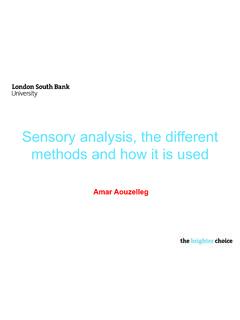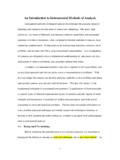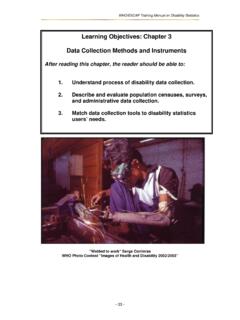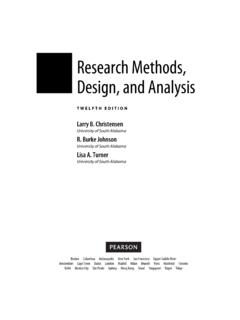Transcription of An Analysis of Multi-Criteria Decision Making Methods
1 1813-713X Copyright 2013 ORSTW International Journal of Operations Research Vol. 10, No. 2, 56 66 (2013) An Analysis of Multi-Criteria Decision Making Methods Mark Velasquez1 and Patrick T. Hester2 Box 64732, Virginia Beach, VA, 23467 2 Department of Engineering Management and Systems Engineering, Old Dominion University, Norfolk, VA USA 23508 Received January 2013; Revised April 2013; Accepted May 2013 Abstract Multi-Criteria Decision Making (MCDM) Methods have evolved to accommodate various types of applications. Dozens of Methods have been developed, with even small variations to existing Methods causing the creation of new branches of research.
2 This paper performs a literature review of common Multi-Criteria Decision Making Methods , examines the advantages and disadvantages of the identified Methods , and explains how their common applications relate to their relative strengths and weaknesses. The Analysis of MCDM Methods performed in this paper provides a clear guide for how MCDM Methods should be used in particular situations. Keywords Multi-Criteria Analysis ; Multi-Criteria Decision Making ; Multi-Criteria Decision Analysis , MCDA, MCDM 1. INTRODUCTION Multi-Criteria Decision Analysis has seen an incredible amount of use over the last several decades. Its role in different application areas has increased significantly, especially as new Methods develop and as old Methods improve.
3 This paper analyzes several common Multi-Criteria Decision Making (MCDM) Methods and determines their applicability to different situations by evaluating their relative advantages and disadvantages. A comprehensive literature review is first performed to allow for a summary of common Multi-Criteria Decision Making Methods . A review of the use of these Methods and an examination of the evolution of their use over time is then performed. In addition to applying single MCDM Methods to real world decisions, the progression of technology over the past couple of decades has allowed for more complex Decision Analysis Methods to be developed.
4 This experimentation with combined Multi-Criteria Decision - Making Methods has provided a whole new approach to Decision Analysis . The advantages and disadvantages of twelve separate Methods identified in the literature review will be discussed. Their common applications will also be examined to see if correlations can be drawn between the use of a given method and its advantages and disadvantages. The conclusion of the paper will reveal that certain MCDM Methods are better suited for specific situations, while other applications should avoid certain Methods altogether. 2. LITERATURE REVIEW AND Analysis OF Methods The literature review examined scholarly literature pertaining to Decision Analysis .
5 In order to identify those articles that provided the most valuable information, a search was conducted for common MCDM Methods in title, abstract, and keywords utilizing the following databases: Elsevier, Springer, ScienceDirect, and IEEE xplore. These included journal articles and conference proceedings concentrating mainly on the areas of operations research and management science. These were narrowed down to articles that focused on application of popular MCDM approaches. Each paper was grouped by its MCDM technique and reviewed thoroughly. The following eleven MCDM Methods were identified throughout the review: 1) Multi-Attribute Utility Theory, 2) Analytic Hierarchy Process, 3) Fuzzy Set Theory, 4) Case-based Reasoning, 5) Data Envelopment Analysis , 6) Simple Multi-Attribute Rating Technique, 7) Goal Programming, 8) ELECTRE, 9) PROMETHEE, 10) Simple Additive Weighting, and 11) Technique for Order of Preference by Similarity to Ideal Solution.
6 The following sections address each particular method first with a summary and discussion of the reviewed studies, and then follow with a brief discussion of the general approach and an examination of the advantages and disadvantages of each method. Corresponding author s email: International Journal of Operations Research 57 Velasquez and Hester: An Analysis of Multi-Criteria Decision Making Methods IJOR Vol. 10, No. 2, 56-66 (2013) Multi-Attribute Utility Theory (MAUT) Literature Review Multi-Attribute Utility Theory (see Fishburn, 1967; Keeney, 1974, 1977) was the most commonly utilized MCDM method identified in this study.
7 MAUT is essentially an extension of Multi-Attribute Value Theory (MAVT) (see Keeney, 1974) and is a more rigorous methodology for how to incorporate risk preferences and uncertainty into multi criteria Decision support Methods (Loken, 2007, p. 1587). Earlier research in MAUT compared it to then-current MCDM Methods . Siskos, Wascher, and Winkels (1983), for example, summarized outranking Methods in Decision Making as well as Multiple Attribute Utility Theory. They presented the ELECTRE I method and provided a brief comparison to MAUT. In the last decade, it has become commonplace for research to utilize MAUT to assist Decision Analysis in real-world problems.
8 Canbolat, Chelst, and Garg (2007) applied a MAUT model to assist in selecting the location of a global manufacturing facility. Ananda and Herath (2005) also used MAUT in a real-world application to analyze risk preferences with regards to forest land-use in Australia. MAUT was utilized due to its common use in natural resource management problems. Their approach centered around societal risk preferences and they utilized a survey to obtain and examine desirable attributes. Gomez-Limon, Arriaza, and Riesgo (2003) utilized Multi-Criteria Decision Making Analysis in regards to risk aversion. They utilized MAUT to address risk aversion coefficients, and their results in comparison to how risk was originally handled appeared to vary widely.
9 The use of Multi-Criteria Decision Analysis allowed for proper Analysis of all risks, an examination of where previous effort had been applied, and a focus on large gaps in the industry s risk assessment. Kailiponi (2010) used MAUT to assist with evacuation decisions that emergency managers are put in place to deal with. The Evacuation Responsiveness by Government Organizations (ERGO) project was put together by the European Commission sought to put together a model for evacuations. The model specifically addressed storm surge scenarios and, by utilizing Multi-Attribute Utility Theory, identified levels where evacuation actions were to be taken by emergency managers.
10 Data was collected from input from emergency managers across eight different countries in Europe. The use of MAUT allowed emergency managers to understand and weigh values properly when preparing to make Decision in emergency situations. Their model allowed for the Analysis of evacuation policies and possible construction of training scenarios. Technology has also evolved to allow complex problems to be addressed with relative ease. The use of Decision support systems (DSS) utilizing a MAUT method, as well as other MCDM Methods , has seen increasing use with relative success. Loetscher and Keller (2002) developed a model using MAUT incorporating technical, socio-cultural and institutional criteria for decisions about implementability and sustainability.









